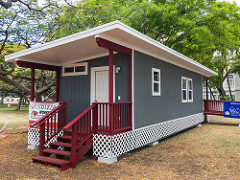In California cities with extremely high property values but low population density, such as Palo Alto and San Jose, the construction of small dwellings in homeowners’ backyards has surged in recent years. This is in part a response to the loosening of local regulations on building footprints and land development.
These backyard developments — which are legally known as accessory dwelling units (ADUs) and usually cost between $30,000 to $300,000 to construct — add a second, smaller dwelling to a residential property.
ADUs can provide homeowners a source of long-term or short-term rental income and can also accommodate aging relatives, larger families and even low-income or homeless renters. In fact, the latter option can come with government subsidies to incentivize construction.
Until very recently, such developments were strictly regulated in California. However, recent changes in attitude have prompted a veritable land rush to develop hundreds of acres of valuable backyard turf.
In 2016, the California legislature legalized the construction of new ADUs across the state and provided a path to legalize pre-existing ones. This landmark reform also eliminated parking offset requirements in certain areas and provided guidelines on how to construct ADUs that could quickly be approved by city planning departments without going through lengthy county supervisor or design-commission approval processes.
The San Francisco Planning Department, which first approved San Francisco ADUs in 2014, advises homeowners with vacant garages or other underutilized space to take advantage of the city’s program.
“Adding an ADU to your property can provide several benefits, such as providing housing for family members, simplifying your lifestyle and increased financial flexibility,” the Planning Department states on their website.
The investment potential of these developments has spurred ADU construction from San Francisco to San Jose, in part as eager startups clamor to offer creative financial and legal assistance in exchange for a slice of the pie.
For example, Palo Alto based ADU Builder, Inc. offers to file paperwork and physically install ADUs for no down payment in exchange for a guaranteed percentage of monthly rental earnings.
Gi Wook Shin, a senior fellow at the Freeman Spogli Institute for International Studies and chair of Stanford’s Korea Program (formerly the Korean Studies Program), rents out a 350-square-foot, one-bedroom casita — or “small house” — near Stanford’s main campus. It costs $2,150 a month: nearly $500 less than the going monthly rate for a one-bedroom apartment in Palo Alto.
Shin did not respond to multiple requests for comment.
As these tiny homes have bolstered local housing supplies and lowered rents, some mayors and supervisors have championed them. Optimistic public officials have praised ADUs as an opportunity to provide much-needed rental space for middle-income workers, while others have emphasized that their potential to serve low-income communities and enable multigenerational living.
However, financing the construction of a casita can be challenging, as banks struggle to determine their value and typically don’t offer loans for them. This has proven to be a significant disincentive to homeowners since ADUs typically cost between $40,000 and $200,000 to build.
Nevertheless, small lenders willing to accept the risk have met at least some of the demand, and certain nonprofits have even begun offering incentivized financing packages for UDAs not intended for monthly rental. For instance, Housing Trust Silicon Valley — a housing nonprofit backed by local businesses and government — offers financial assistance to homeowners who rent out their ADUs to extremely low-income renters escaping homelessness. It also encourages multigenerational living.
On Nov. 1, East Palo Alto Mayor Ruben Abrica, a longtime champion of below-market-rate construction who received his Masters in Education at Stanford in 1978, questioned whether the traditional American “home with a yard” accommodates immigrant families.
“In the Latino community, in the Mexican community, we are kind of big on extended families, so our sense of family is that at some point the grandma is going to move here or an aunt or uncle,” he said at a housing-themed event hosted by Stanford in Government on Nov. 1. “And not a lot of housing is developed that way, to accommodate a second unit.”
As the United States’ demographics shift older and older, the promise of multigenerational living arrangements has become increasingly attractive for families and especially those with cultural traditions of having several generations live under the same roof.
However, not everyone takes so positive an outlook. Evander Deocariza ’20, a current Stanford junior who is co-leading the 2019 Alternative Spring Break trip “Capital or Community: Housing Inequality in the Bay Area,” told The Daily that ADUs are only a short-term fix for the housing crunch.
“Building ADUs is insufficient to tackle the enormity of the [housing] problem here in the Bay Area,” Deocariza said. “We have way more people working who want housing near where they work.”
Deocariza also pointed out that ADUs can be perceived as a “band-aid measure” designed to mitigate the housing problem without forcing policy makers and activists to do the hard work of rethinking housing development patterns and creating the infrastructure necessary to fix the problem.
Stanford’s guarantee of undergraduate housing may shield students from the worst of the local housing crunch, but for those who remain in the Bay Area after graduation, their next accomodation might well be an ADU.
Contact Cooper Veit at cveit ‘at’ stanford.edu.
